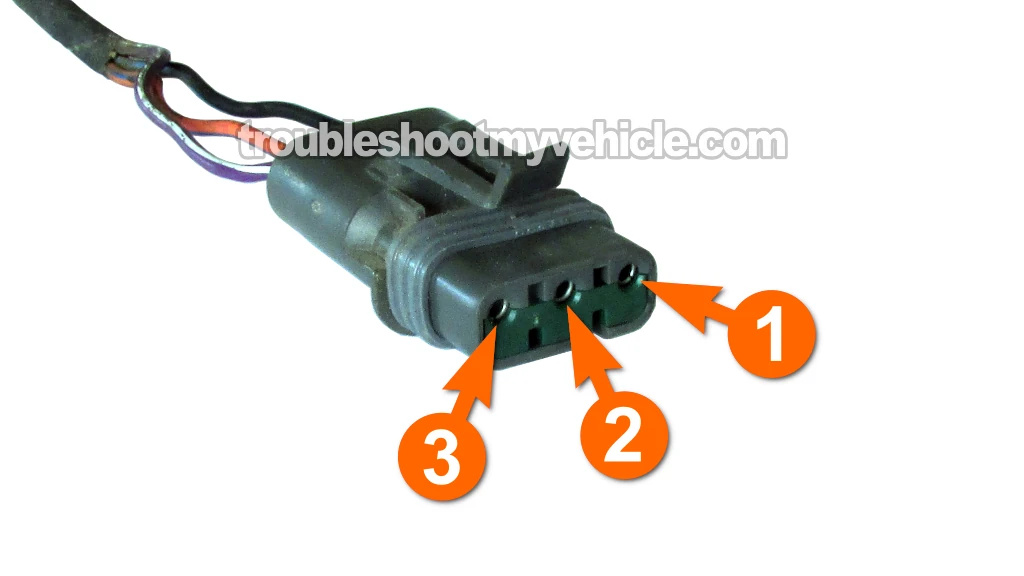
The throttle position sensor (TPS) provides one of the most crucial pieces of information your 1991-1995 3.0L V6 Chrysler, Dodge, or Plymouth vehicle needs to run correctly.
Fortunately, when it fails, it's not difficult to test. In this tutorial, I'll show you how to check that it's generating a TPS signal, receiving 5 volts, and has a good Ground.
You'll also be able to diagnose any of the following OBD I TPS trouble codes that may be lighting up the check engine light:
- Trouble Code 24: TPS Voltage Low.
- Trouble Code 24: TPS Voltage High.
Contents of this tutorial:
ES ![]() You can find this tutorial in Spanish here: Cómo Probar El Sensor TPS (1991-1995 3.0L Chrysler, Dodge, Plymouth) (at: autotecnico-online.com).
You can find this tutorial in Spanish here: Cómo Probar El Sensor TPS (1991-1995 3.0L Chrysler, Dodge, Plymouth) (at: autotecnico-online.com).
Basics Of The Throttle Position Sensor (TPS)

As you step on, or off, the accelerator, the throttle plate (on the intake manifold's throttle body) opens or closes.
This throttle plate action lets more (or less) air into the engine.
The throttle position sensor's job is to measure the throttle plate opens and closes and then relay this throttle plate angle info to your vehicle's fuel injection computer.
Once the fuel injection computer, receives this throttle plate angle information, it can inject the correct amount of fuel for the amount of air entering the engine.
As you're already aware, the throttle position sensor (TPS) has 3 wires coming out of its harness connector and the middle wire is the one that sends the TP signal back to the computer. The other two wires provide power and Ground (to the TPS).
In the table below, you'll find a short description of what each wire does:
| Pin | Wire Color | Description |
|---|---|---|
| 1 | BLK/LT BLU | Sensor Ground |
| 2 | ORG/DK BLU (or DK BLU) | Throttle Position Signal |
| 3 | VIO/WHT (or VIO) | 5 Volts |
Where To Buy The TPS And Save
You can buy the throttle position sensor for your Chrysler in just about any auto parts store but you'll spend a whole lot more because they mark it up quite a bit.
My suggestion is to buy it online or at least comparison shop to get an idea of how much it costs and how much you can save.
The following links are for known automotive brand name throttle position sensors (avoid knock-off parts):
- Standard Motor Products TH70 Throttle Position Sensor (at: amazon.com)
- Walker Products 200-1010 Throttle Position Sensor (at: amazon.com)
Disclosure: As an Amazon Associate, I earn from qualifying purchases. If my tutorials help you, using these links is an easy way to support the site at no extra cost to you. Thank you!
TEST 1: Checking The Throttle Position Sensor (TPS) Signal

9 times out of 10, when the throttle position sensor fails, it simply stops creating a throttle plate signal.
To explain this a bit further: In a good throttle position sensor, as the throttle plate angle increases, the TP signal's voltage increases and as the throttle angle decreases, the TP signal's voltage decreases.
So, in this first test, we'll tap into the throttle position sensor's middle wire with a multimeter and see if the voltage signal increases when you open up the throttle plate and decreases when you close the throttle plate.
IMPORTANT: This is an on car test of the sensor and the throttle position sensor must remain connected to its harness connector. Also, depending on your specific vehicle, the middle wire of the TPS harness connector will be an ORG/DK BLU wire or a DK BLU wire
Here are the test steps:
- 1
Set your multimeter to its DC Volts function.
- 2
Connect the black probe of the multimeter directly to the negative (-) terminal of the battery.
- 3
Turn the key to the RUN position but don't crank or start the engine.
- 4
Connect the red probe to the ORG/DK BLU or DK BLU wire of the TPS sensor connector.
The ORG/DK BLU or DK BLU wire connects to the terminal labeled with the number 2 in the connector illustration above.
NOTE: The TPS sensor should be connected to its connector, so you'll need to use a back probe on the backside of the connector or use a wire piercing probe to reach the signal within the wire (to see an example of this tool and where to buy it: Wire Piercing Probe). - 5
Your multimeter should read a voltage between 0.3 and 1.0 Volts DC with the throttle closed.
- 6
Manually open the throttle.
NOTE: You'll get the best results by opening and closing the throttle directly at the throttle body instead of stepping on the gas pedal. - 7
The multimeter should display a voltage that increases as you (or your helper) open the throttle.
With the throttle fully open, your multimeter should read: 3.2 to 4.9 Volts DC. - 8
Slowly close the throttle.
- 9
The multimeter should display a voltage that decreases as you start to close the throttle.
- 10
Using the handle of a screwdriver, lightly tap the TPS sensor while you open and close the throttle and watch the multimeter.
The purpose (of tapping the TPS sensor with the screwdriver handle) is to see if the TPS sensor shows any gaps in the voltage signal. Why? Because a good TPS sensor will show a voltage signal that continually increases or decreases even as the screwdriver handle taps it.
Let's take a look at what your test results mean:
CASE 1: The TP sensor signal's voltage increased and decreased smoothly and without gaps. This tells that the throttle position sensor on you car (or mini-van) IS NOT defective.
Since the throttle position sensor is creating an increasing/decreasing voltage signal on the ORG/DK BLU wire, this test result also says that:
- The TPS is getting power on the VIO/WHT wire of its harness connector.
- The TPS is getting Ground on the BLK/LT BLU wire of its harness connector.
CASE 2: The TP sensor signal's voltage did not increase or decrease. This test result usually means that the throttle position sensor on your car (or mini-van) is bad and needs to be replaced.
To make sure it's defective, I suggest that you verify that it's getting power and Ground. So, to continue with the TPS diagnostic, go to: TEST 2: Making Sure The TPS Is Getting Power.
CASE 3: The TP sensor signal's voltage showed gaps in its voltage output as you tapped the sensor with the screwdriver. If the gaps in the multimeter's voltage readings only showed up when you were tapping on the TPS (with the screwdriver's handle) then this test result tells you that the TPS is bad and needs to be replaced.


